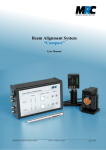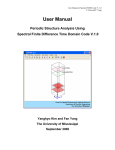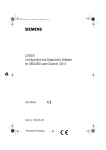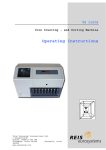Download Beam Alignment System “Dynamic”
Transcript
Beam Alignment System “Dynamic” User Manual Dynamic Beam Stabilization - Manual version 8 – 12.08.2013 page 1 of 18 Inhaltsverzeichnis 1. General.........................................................................................................................................3 2. System components.....................................................................................................................3 3. Specification................................................................................................................................4 3.1. Positioning accuracy........................................................................................................................5 4. Installation and operation.............................................................................................................6 4.1. Brief “step-by-step” instruction.......................................................................................................6 4.2. Introduction.....................................................................................................................................7 4.3. Set-up of optical components..........................................................................................................7 4.4. Inputs and outputs...........................................................................................................................9 4.5. Intensity adjustment......................................................................................................................10 4.6. Direction coding of detector outputs.............................................................................................10 4.7. Optimization of laser beam position on detectors..........................................................................11 5. Operation and safety features.....................................................................................................11 5.1. Power level display.......................................................................................................................11 5.2. Low power switch-off...................................................................................................................11 5.3. Switch-on activity delay................................................................................................................11 5.4. Turn-switch for signal amplification.............................................................................................12 5.5. Controller status signal (OK)........................................................................................................12 5.6. Bandwidth limitation switch..........................................................................................................12 6. Optical components...................................................................................................................13 6.1. Steering mirror PKS......................................................................................................................13 6.2. Steering mirror PSH......................................................................................................................13 6.3. Detectors.......................................................................................................................................14 7. Drawings....................................................................................................................................15 7.1. Mirror mount PKS.........................................................................................................................15 7.2. Mirror mount PSH.........................................................................................................................15 7.3. Detector housing ..........................................................................................................................16 8. Troubleshooting.........................................................................................................................16 8.1. No signals on display....................................................................................................................16 8.2. The laser beam is not correctly positioned....................................................................................16 8.3. The steering mirrors make exceptional noise................................................................................16 8.4. Laser position is not stable............................................................................................................17 9. Safety.........................................................................................................................................17 10. Check list for laser data...........................................................................................................18 10.1. Set-up data...................................................................................................................................18 10.2. Actuated mirrors..........................................................................................................................18 11. Contact.....................................................................................................................................18 Dynamic Beam Stabilization - Manual version 8 – 12.08.2013 page 2 of 18 1. General The Dynamic laser beam stabilization compensates for vibrations, shocks, thermal drift, or other undesired fluctuations of the laser beam direction. The system should be applied whenever laser fluctuations or movements of optical components occur but a high precision and stability of the beam direction is required. The desired position of the laser beam is defined by the centre of a 4-quadrant-diode (4-QD) or a PSD. For that purpose a small portion of laser power transmitted through a high-reflective 90° deflection mirror is sufficient (see figures 3 and 4). Figure 1: Principle of laser beam stabilization The closed-loop controller continuously determines the deviation of the laser beam from the desired position and drives the fast actuators in that way that the steering mirrors stabilize the laser beam in the desired position. The system is available in two different models. The 2-axes system comprises one detector and one steering mirror that deflects the laser beam in two axes. Thus, the laser beam is fixed in one position but the laser beam direction can change. The 4-axes system combines two detector and steering mirror pairs in order to detect the laser beam at two distant positions. Thereby both, position and direction are fixed. 2. System components The laser beam stabilization utilizes optoelectronic components (detectors, steering mirrors) as well as electronic modules. We offer different types of actuators and detectors. For more details please check the specification in section 3 and the photos in section 6. Figures 2, 3, and 4 (from left to right): Steering mirror with Piezo drive (version PSH), steering mirror with detector, separate detector Dynamic Beam Stabilization - Manual version 8 – 12.08.2013 page 3 of 18 The system comprises the following electronic modules: • • • • Power supply for Piezo amplifiers (“PS-A”) Piezo amplifier (“Piezo Amplifier”) Controller module (“Active Beam Align”) Power supply for controller module (“PS-C”) Figure 5: Electronic modules for 4-axes system (with 2 Piezo amplifiers) 3. Specification Optical parameters Wavelength Laser repetition rate Laser beam diameter Height of laser beam Mirror diameter Mirror thickness 320 to 1100 nm, see also note 2 > 100 Hz or cw < 6 mm (1/e²), see also note 1 37 mm (Please ask for adapters if you need other heights.) 1" (standard), other mirror mounts on request 1/4'' or 1/8" (recommended) Controller housing dimensions Rack units 19'' rack, 3HE/U, 84TE Position detector Detector type Bandwidth Detection area Optical filter Si 4-quadrant diode (for standard wavelengths), see also note 2 < 10 kHz 10 x 10 mm² (for standard wavelengths), see also note 2 11.9 x 11.9 mm2 Steering mirror Type 1: PKS (K-700-31) Actuator type Bandwidth Maximum tilt Type 2: PSH (K-102-10) Actuator type Bandwidth Maximum tilt Dynamic Beam Stabilization - Manual Piezo electric elements < 700 Hz (measured with 1'' mirrors, thickness: 0.125'') < 1 mrad (± 0.5 mrad) Piezo electric elements < 840 Hz (measured with 1'' mirrors, thickness: 0.125'') < 2 mrad (± 1 mrad) version 8 – 12.08.2013 page 4 of 18 Control features Power level display Low power switch-off Switch on activity delay Adjustable signal amplification LED bar with 10 elements Switch-off, if power level falls below 10% of saturation power 300 ms 3 levels: ×1, ×4, ×14 Connectors at electronic rack Actuator Controller status signal (Interlock) 4-QD in x and y position out LEMO 0S LEMO 00 LEMO 0B MCX Cable lengths Detector → Controller (2 cables) Actuator → Controller (2 cables) Actuator → Controller (Elongation) x-y-position cable (2 cables) 4 m (other lengths on request) PKS: 1.5 m (directly mounted to Piezo element) PSH: 1.2 m (directly mounted to Piezo element) 10 m (one pair of cables for one actuator is included in delivery, additional or other cables on request) 2 m (other lengths on request) Notes: (1) In case the beam diameter is larger than 6-8 mm, a lens in front of the detector can be used. For larger beam diameters adapters for 2'' or other mirrors are available (on request, see also figure 11b in section 6.2). (2) UV and IR detectors are available on request. They may have differing dimensions and detection areas. As an alternative to the 4-QDs we also offer PSDs. These can have different dimensions and sensitive areas, too. 3.1. Positioning accuracy The positioning accuracy depends on several parameters: Optical distance between steering mirror and detector: The accuracy is higher for larger distances. Therefore a large distance should be chosen. The first steering mirror should be placed close to the fluctuation source. • Beam diameter: Having the same absolute change of laser beam position, a smaller diameter leads to stronger power differences on the quadrants and therefore a steeper control signal. That is why laser beams with smaller diameters can be positioned with higher accuracy. • Intensity: The resolution of the detectors further depends on the intensity hitting the sensitive area. This can be varied by an appropriate choice of optical filters and optimised electronically (see also section 5.4). • Repetition rate and pulse duration: The controller bandwidth can be optimised for different laser parameters. A higher bandwidth leads to a faster reaction and therefore higher accuracy in case of fast fluctuations. • In figure 6 the typical resolutions of the detectors are displayed. The example shows that a resolution of better than 100 nm on the detectors can be achieved with an appropriate choice of parameters. The angular resolution can be determined from these data with respect to the respective arm lengths. Dynamic Beam Stabilization - Manual version 8 – 12.08.2013 page 5 of 18 Figure 6: Resolution of a 4-quadrant-diode irradiated by a red He-Ne laser with different beam diameters and laser intensities The actuators are controlled with an analog signal so that the positioning is not restricted to separate steps. The positioning accuracy of the Piezo elements are specified as < 2nrad (PKS) and 4 nrad (PSH). 4. Installation and operation 4.1. Brief “step-by-step” instruction The following steps shall assist you during the first startup of the beam stabilisation. The following section will then explain the single steps more comprehensively. 1) Robust set-up of optical components (steering mirrors and detectors): The centres of the detectors define the beam position. The detectors can be placed directly behind mirrors. Alternatively, a small portion of the beam can be deflected to the detectors by means of a beam splitter. 2) Cable connection: First mirror with X and Y outputs of left Piezo Amplifier, second mirror with X and Y outputs of right Piezo Amplifier. First detector with left 4QD input, second detector with right 4QD input. 3) Switch on power supply (switch on rear side of housing): Thereupon the green Range LEDs will shine at the Piezo Amplifier modules. 4) Adjustment of intensity on detectors (by means of the turn switches Gain and if necessary exchange of optical filters): In the best case 9 LEDs should be shining. 5) Pre-adjustment: Adjustment of the laser beam onto the detectors. Activate the controller module (Adjust switch in lower position, green Active-LED shining) and adjust the laser beam onto the detectors by means of manually tilting the steering mirrors until the four Range signals on the Piezo amplifiers are shining green. If this is not possible, the reason might be a wrong direction coding. In this case go to step 6. 6) Direction coding: Activation of control stage 1. If during the pre-alignment step the red LEDs are jumping between the upper and the lower red Range LED the switch position for x and y direction should be changed (see section 4.6). Dynamic Beam Stabilization - Manual version 8 – 12.08.2013 page 6 of 18 7) Direction coding according to step 6, now for stage 2. 8) Fine-tuning for control stage 1: Deactivate both control stages (Active-LEDs do not shine). Then follow the description in section 4.7 until the x and y position outputs are close to 0V. 9) Fine-tuning for control stage 2: Activate stage 1 (Stage 2 is still deactivated). Then proceed according to section 4.7. 10) For the stabilised operation of 4 axes activate both stages. 4.2. Introduction The system operation can be described with reference to figure 5. The Active Beam Align slot includes the connectors, switches and displays for two detectors (“stage 1” and “stage 2”). For each actuator there is a separate Piezo Amplifier slot. Each stage can be activated independently by means of the Adjust switch. Adjust in lower position means the stage is active, Adjust in upper position means it is not active. The Range display shows whether or not the steering mirrors are within the available capture range. The Active LED is shining whenever the control stage is active. This is the case whenever the laser power on the detector has the right level. The position outputs besides the intensity level bars can be used to read out the current position of the laser beam on each 4-quadrant diode (x and y). Notes: (1) Whenever the system is activated by means of the Adjust switch the actuators start to move from the zero position and then respond to the controller input. (2) If a Range LED is shining red, this does not automatically mean that the beam is not stable. But it indicates that no further tilt of the respective steering mirror is possible although it might be necessary. (3) If the power on the detectors is too low the actuators are driven to the zero position (and the Active LED is off). This is due to the low power switch-off that is implemented for safety reasons (see section 5). The cable connection is quite intuitive. You can follow the instructions in section 4.4. The internal direction switches enable a coding of the x and y directions of each controller stage. They are connected with 4QD-1 and 4QD-2, respectively. The performance is further described in section 4.6. The function of the bandwidth limitation switch is explained in section 5.6. The status signal output (OK) can be used as an interlock or to drive a shutter (see section 5.5). Note: The Piezo elements have a large electrical capacity. That is why the cables should not be disconnected as long as the Piezo elements are charged. i.e. you should always switch off the power of the stabilisation system on the rear side of the rack and then wait for a few seconds before you disconnect the actuator cables. 4.3. Set-up of optical components The optical components (steering mirrors and detectors) can be configured in variable arrangements for different applications. The detectors can be placed behind high-reflection mirrors. They are very sensitive and can work with the leakage behind the mirrors. This has the advantage, that no additional components are required in the beam path. Alternatively, it is possible to use the reflection of a glass plate or beam splitter in the beam path. The latter can be necessary for lasers with larger beam sizes where the actuator would constrain the Dynamic Beam Stabilization - Manual version 8 – 12.08.2013 page 7 of 18 transmission. In any case, the centres of the 4-QDs are positioned in that way, that they define the desired laser beam direction. The first actuator should be placed close to the laser or the last source of interference. The last detector should be placed close to the target. Note: Take care for a robust mechanical mounting of the optical components. If possible the delivered components should be directly tightened to an optical table without further positioning equipment (like height adjustment). If there are oscillating components with resonance frequencies within the control bandwidth in the set-up, such resonances can provoke oscillations of the system at that frequency. The following figures 7a-e show a selection of possible arrangements. These examples are demonstrated with the 4-axes system with 4QDs. However, they can be applied in similar configurations for the 2-axes system with only one actuator and one detector. • Figure 7a shows a typical 4-axes set-up of the system where the laser beam hits the optical components in the following sequence: steering mirror, combination of steering mirror and detector, mirror with detector. • Figure 7b shows a similar set-up where additional lenses are placed in front of the detectors. Further, a beam splitter is integrated in the beam path. This set-up might be better for lasers with large beam diameters. • In figure 7c a lens was placed in front of detector 2 in order to improve the angular resolution. In this case, the distance between lens and detector should be the focal length of the lens. The focal length itself should be chosen in that way – depending on the beam diameter – that the focal spot is not too small. The beam should still have a diameter on the sensor area of > 50 µm, so that it hits all quadrants of the diode. (The gap between the quadrants of our standard 4QD measures 30 µm.) • Figure 7d shows a variation of 7c where both detectors are placed behind the same mirror. A lens is placed in front of one detector in order to measure both, the beam position and the direction at the same point. • Figure 7e finally shows a different arrangement where the 4-axes system is used as two 2-axes systems, i.e. the two stages of the controller are used to separately stabilize two independent beam lines. Figure 7a: Typical sequence of components for the 4axes stabilisation: Detector 1 stabilises the beam position on actuator 2. Detector 2 then defines the beam position at a separate point and hence the direction. Dynamic Beam Stabilization - Manual Figure 7b: Set-up as in 7a, with an additional beam splitter and a lens in front of detector 1 and an additional lens in front of detector 2 (Often used for lasers with larger beam diameters) version 8 – 12.08.2013 page 8 of 18 Figure 7c: Set-up as in 7a, but a lens is used to discriminate the angle by means of detector 2. This can be of advantage in case of restricted space with small distances between the optical components. Detector 2 must be placed in the focal plane of the lens. Figure 7d: In this set-up both detectors are placed behind the same mirror. Here, the beam position and the direction are stabilised in close distance to the application. Again, as in figure 7c detector 2 is used to discriminate the angle. Figure 7e: Set-up of a 4-axes system used as two 2-axes systems. With this set-up the position of two independent lasers can be stabilised with one controller. 4.4. Inputs and outputs The first steering mirror (figure 2) is connected to the left Piezo Amplifier whereby the upper output drives the x (horizontal) direction and the lower output drives the y (vertical) direction. The second steering mirror (with detector, figure 3) is connected to the right Piezo Amplifier in the same way. The signals of the first 4-QD (in the 4-axis system combined with the second steering mirror) are connected to the Stage 1 4QD In input at the controller module. The signals of the second detector are connected to the Stage 2 4QD In input. Dynamic Beam Stabilization - Manual version 8 – 12.08.2013 page 9 of 18 Note: • • The PKS steering mirror mounts can be mounted in two orthogonal orientations. In the standard factory installation they are mounted and labelled in that way that the x axes drives the horizontal tilt and the y axis drives the vertical tilt. If you change the orientation please take care that always the horizontal tilt must be connected to the x input and the vertical tilt must be connected to the y input of the controller box. In case of the 2-axes system, the signals of the one detector are connected to the Stage 1 4QD In input. 4.5. Intensity adjustment To make sure that the detectors operate in the linear range, the power level can be adjusted by means of the turn-switch Gain for signal amplification. For that purpose, switch on the system (Power on) and inactivate the closed-loop control (Adjust switch in upper position, green Active-LED dark). Then adjust the laser beam onto the detectors in that way that at least 3 but not more than 9 elements of the power level display are shining. The amplification increases by clockwise rotation. If you do not find an appropriate adjustment you have to exchange the optical filters in front of the 4QDs. If the required filters are not available please contact the manufacturer or distributor. Notes: • • In a standard delivery we integrate two optical filters in front of the sensor area. These are filters with a high and a low density for coarse and fine adjustment, respectively. Usually the filter which is the first to be reached is the low density one. Please be aware that the sensor area is quite sensitive. If you want to clean it you should do this carefully with an antistatic cloth. If you want to exchange the filters you can detach the plastic screws which fix the filters in the housing. With a tilt of the detector housing it should be possible to release the filters. Once you put in new filters please be careful so that you do not damage the detector. Finally you can fix them with the plastic screws. 4.6. Direction coding of detector outputs For any deviation of the laser beam position on a detector the respective steering mirror is tilted in that way that it adjusts the laser beam back to the desired position. Each control stage makes use of a steering mirror and a detector as described in the previous sections. The components that are working together are identically coloured in figures 7a-e. The direction in which the steering mirror must be tilted depends on the arrangement of detector and steering mirror. It can be changed during the pre-adjustment process described in section 4.7 in the following way: There are four red switches on the top of the cassette of the controller module that can be reached after removing the cover of the electronic housing (see figure 8). These switches stand for the x- and ydirections of the control stages Stage 1 and Stage 2. To turn them into the correct position just switch on the respective stage. If the laser beam is then deflected into an extreme x (horizontal) and/or y (vertical) position instead of the centre of the detector, you have to toggle the belonging switch. Dynamic Beam Stabilization - Manual version 8 – 12.08.2013 page 10 of 18 Figure 8: Switches for direction coding 4.7. Optimization of laser beam position on detectors i. Pre-adjustment (obtaining linear range of steering mirrors) Activate the controller module (Adjust switch in lower position, green Active-LED shining) and adjust the laser beam onto the detectors by means of manually tilting the steering mirrors until the four Range signals on the Piezo amplifiers are shining green. Now the steering mirrors are operating in their linear range. ii. Fine-adjustment (obtaining zero position and full range of Piezo drives) Inactivate the controller module (Piezo drives are in zero position, green Active-LEDs are dark) and adjust the laser beam by means of manually tilting the steering mirrors in that way, that it hits the centres of the 4-QDs. This can be done by reading out the x and y position outputs of the controller module. These outputs deliver a voltage signal that is directly proportional to the deviation from the desired position. You can easily display these signals on an oscilloscope. The better the correlation of desired position and zero position, the smaller the position shift after activating the closed-loop control. After these adjustments the system should show no fluctuations of laser beam position when the controller is activated. 5. Operation and safety features 5.1. Power level display The total power on each connected 4-QD (measured as the sum power on all quadrants) is displayed by means of an LED bar at the controller module. 5.2. Low power switch-off If the total power falls below 10% of the saturation power (and only one LED of the power level display is on) the controller module automatically drives the mirrors into zero position. This leads to the advantage that the closed-loop control can start from the zero position even if the laser was switched off or blocked. 5.3. Switch-on activity delay The integrated switch-on activity delay starts the controller module not before a short time has passed and the steering mirrors have reached the zero position. The Active-LED will not shine during this delay. Dynamic Beam Stabilization - Manual version 8 – 12.08.2013 page 11 of 18 5.4. Turn-switch for signal amplification For an easy adjustment of the signal amplification for optimizing the power level the turn-switch marked with Gain on the front of the Active Beam Align slot can be used. It is directly above the detector input connector. The amplification can be adjusted in three levels (×1, ×4, ×14). This enables the optimization of the power level without an exchange of optical filters. 5.5. Controller status signal (OK) If the system is completely switched off (power off), the Piezo actuators tilt the steering mirror into an extreme position. This is about 0.5 mrad (PKS mount) or 1 mrad (PSH mount) from the zero position. However, the system is equipped with a TTL output that can be used to block or electronically switch off the laser in order to avoid damage by the misaligned beam. The level is HIGH whenever the controller module is active and the steering mirrors are in the correct position or in zero position. It is LOW if the module is active and one of the actuators is out of range. (If the controller module is not active, the level is always HIGH.) 5.6. Bandwidth limitation switch The controller bandwidth directly influences the quality of the stabilization. The system can be operated with two different controller bandwidths. The default setting is the high bandwidth. However, especially in case of unstable mechanical set-ups or if mutual interference of the control stages occurs it can be of advantage to choose the low bandwidth. Therefore a bandwidth limitation (BW) switch is located on the rear side of the Active Beam Alignment module (see figure 9). The bandwidth can be chosen independently for both stages. Figure 9: Bandwidth switch Note: The system uses the intensity centre of the transversal laser beam profile. It does not reduce fluctuations of the laser beam profile itself. Dynamic Beam Stabilization - Manual version 8 – 12.08.2013 page 12 of 18 6. Optical components 6.1. Steering mirror PKS The mirror mount PKS has a tilting range of ± 0,5 mrad which is smaller than the range of the PSH mount. In comparison, it offers a wider free space behind the mirror. The mount can be adjusted manually for coarse adjustment. Figure 10 shows a photo of this mount. Figure 10: Steering mirror mount PKS with 1'' mirror. The blue arrows point to the x and y labels 6.2. Steering mirror PSH The mirror mount PSH has a wider tilting range of ± 1 mrad. It can also be adjusted manually for preadjustment to the zero-position. The mirror mount is optimised for high stiffness by means of reinforced springs and a balancing weight. The standard mount is used with 1'' mirrors. But it can be equipped with adapters for bigger mirror sizes. Figure 11a: Steering mirror mount PSH with 1'' mirror Dynamic Beam Stabilization - Manual Figure 11b: Steering mirror mount PSH with adapter for 2'' mirrors version 8 – 12.08.2013 page 13 of 18 Notes: • • The movable plate of the Piezo elements is sensitive to mechanical forces. Please avoid the impact of strong forces or torsional moments on this plate. The Piezo stack is directly attached to this plate. If you intend to remove the 2'' adapter you should be especially careful. We can provide a specific instruction and a tool for this purpose. 6.3. Detectors Figure 12 shows the 4-quadrant diode with its post. The outer dimensions of the PSD housing and the housing of the UV detector are identical. Figure 12: Detector (4-quadrant-diode with sensitive area of 10x10 mm2 in case of the visible sensor and 3x3 mm2 in case of the UV sensor) Dynamic Beam Stabilization - Manual version 8 – 12.08.2013 page 14 of 18 7. Drawings 7.1. Mirror mount PKS Figure 13: Mirror mount PKS. For a better overview a typical path of a laser beam is displayed. 7.2. Mirror mount PSH Figure 14: Mirror mount PSH. For a better overview a typical path of a laser beam is displayed. Dynamic Beam Stabilization - Manual version 8 – 12.08.2013 page 15 of 18 7.3. Detector housing Figure 15: Detector housing 8. Troubleshooting 8.1. No signals on display Please check if the power line chord is connected to a conducting power plug and if the power switch is on. If everything is okay with the power line, remove the line chord from the electronic rack and check the fuse (below the power switch). Replace the fuse if necessary. If the fuse is okay please contact the manufacturer or distributor. 8.2. The laser beam is not correctly positioned Please check the following issues: i. Are all LEMO plugs of each steering mirror correctly connected to the amplifier? ii. Is the laser power in the allowed range? iii. If a red Range-LED is on: a. Are all cables connected as described in section 4.4? b. Is the initial position of the laser beam in an acceptable position? If the initial position has changed strongly the closed-loop control does not work in the linear range any more. Please refer then to section 4.7. c. Is the direction coding correct? 8.3. The steering mirrors make exceptional noise Please immediately switch off the system. Irreparable damage to the steering mirrors can occur. Then check the laser power on the detectors and adjust it as described in section 4. 5. Make sure that the initial laser beam has not changed strongly and that it hits the 4-QDs. Take care that the beam is not blocked by an aperture or an edge anywhere in the beam path. This could be the case at the cut-out of the Piezo Dynamic Beam Stabilization - Manual version 8 – 12.08.2013 page 16 of 18 actuator. If a red Range-LED is on, the closed-loop control does not work in the linear range any more. Please refer to section 4.7 then. 8.4. Laser position is not stable If the automated stabilization of the laser beam does not work although the controller is active this might be due to a wrong direction coding of the 4-QD outputs (see section 4.6). Please check the direction coding. Another reason might be an unstable mechanical set-up leading to oscillations of the system. Usually this phenomenon is accompanied by an exceptional humming noise. E.g. high positions of components (especially of those carrying the Piezo elements) can lead to mechanical instabilities. In this case a better stabilization can be achieved with a lower controller bandwidth. Please activate the bandwidth limitation switch (see section 5.6). 9. Safety The system has left our factory in a faultless state. Please only store and operate the system in dry environments in order to maintain this state. The device was designed and manufactured according to DIN EN 61000-3-2 and satisfies the requirements of the European EMC Directive 89/336/EWG. Label (example) SN: ABA-01115-xxx Model: 1kHz-CW AC 220-240V, 50/60Hz, 4A MRC Systems GmbH Hans-Bunte-Str. 10 D-69123 Heidelberg Germany Figure 16: Label on the controller electronics Dynamic Beam Stabilization - Manual version 8 – 12.08.2013 page 17 of 18 10. Check list for laser data For the final layout of the system and for an optimal support of your integration it can be helpful to know your laser and set-up data. You can send us your data according to the following compilation: wavelength / range .............................................. average laser power .............................................. pulse duration .............................................. (fill in “cw” in case of a cw laser) repetition rate .............................................. (not applicable in case of a cw laser) beam diameter .............................................. beam profile .............................................. .............................................. (qualitative specs as “Gaussian”, „elliptical”, etc. are sufficient) 10.1. Set-up data If possible, please send us a drawing or a photo or your intended set-up. We can then give you recommendations for the integration of the stabilisation system. We have our focus on an easy arrangement of the optical components and on appropriate distances between actuators and detectors (“arm lengths”) since they determine the reachable angular resolution. 10.2. Actuated mirrors Please let us know if we shall provide the mirrors: Who will provide the mirrors? □ Customer □ MRC (on request, on account) The following mirror sizes are recommended: • standard: diameter 1'', thickness 1/4'' (1/8'' as an alternative) • on request: diameter 2'' 11. Contact MRC Systems GmbH Hans-Bunte-Strasse 10 D-69123 Heidelberg Germany Phone: 06221/13803-00 Fax: 06221/13803-01 Website: www.mrc-systems.de E-mail: [email protected] Dynamic Beam Stabilization - Manual version 8 – 12.08.2013 page 18 of 18



























